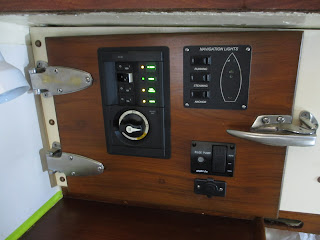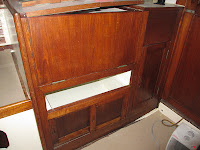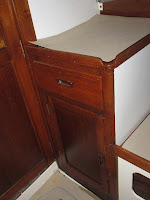
We finally have independent power aboard! As a reward for two weeks of sanding and 1 of the 2 coats of varnish put on, I opened up the check book and invested in the expensive part of the power plant. For the house batteries, I have two 6 volt golf cart batteries (GC2-XHD-UTL) from Interstate. Why did I choose these. The industry benchmark seems to be Trojan Batteries; the T-105's to be specific. They are some of the best performing and more expensive batteries you can find. The Interstate's are listed as a replacement for the T105's but on closer inspection actually have specs that are a tad bit better.
Comparing the total Amp Hr ratings, which is what we really need to look at for house batteries, the Trojans are at 225 Ah and the GC2's are at 232 Ah. The reserve capacity at 25 amps is 447 vs 475 and at 75 amps is 115 vs 122. Everything is just a bit higher on the GC2's, including the weight. 62lbs vs 67lbs. You would expect more weight to come from heavier plates and that translates into better performance. The second reason I went this way is that through work we get a discount at Interstate Battery. So I ended up with slightly better performance and lower initial cost. The only unknown is longevity. We shall see.

In the photo you can see the two 6-volts wired together in their battery boxes mounted under the lazzerette on the starboard side. The funny looking yellow cable with the blue tape is to identify the jumper cable from the neg. on one battery to the pos. on the other, combining them to be a 12-volt bank. You can also see the 125A Mega Fuse on the positive side and the negative bus both mounted on the cockpit side wall support. There is still some wire management I have to do to make it neater but we now have House Power!
The Starter Battery is under the port lazzerette and is a Group 27 Interstate Battery (SRM-27) loosely based on a Trojan SCS200 spec. This time the Trojan has a much better product. In CCA (cold cranking amps) the Trojan is at 620 while the Interstate is at 600. RC at 25 amps is 200 vs 160. This concerns me less on this battery because I also have the battery switch that can combine both banks for starting if need be and a starter battery I expect to wear out faster than the house bank. I may regret that decision but I did save a few dollars on this round.

Both banks are also connected to a ACR (Automatic Charge Regulator) which is mounted on the rear cockpit bulkhead. Each connection from the bank runs through a 100 A Mega fuse and the ACR is grounded through a fused Neg wire back to the neg bus. This will allow a charge source at one bank to spill over and charge the other bank. More specifically when the engine is running and the alternator is putting juice back into the starter battery, the extra charge goes over to the house bank. If there is an external charge source going to the house bank, shore power or solar power for example, then the extra charge goes over into the starter battery.


It was nice to turn on the battery switch and have power lights come on. Hit the breakers and turn interior lights on. I did also start the motor again with the new starter battery and it fired right up. I was worried about it not starting as before and was really concerned I had an air leak in the fuel system. In my reading online about this problem I learned that the Yanmar manual says to set the throttle to high when starting (without the prop engaged of course). I had been starting the motor at idle. Makes a big difference.
I am not overly thrilled with my choice of LED reading lights. You get what you pay for. They are cheap but they do work, although the shades have all worked loose. I plan on pouring in some epoxy at the base to permanently set the shade to the post. I did get one coat of matte spar varnish on the interior wood work after all that sanding. It needs a light sanding now and another coat. I finished up the boom tip painting with the fourth coat and it has done what I wanted it to do. Sealed the wood, finished the end and will give me a good visual when the boom swings over.



















